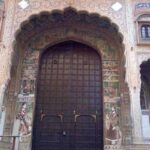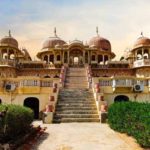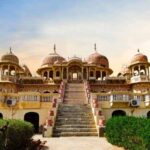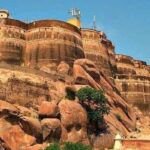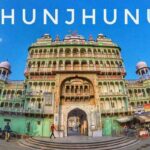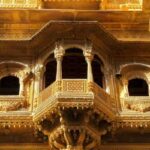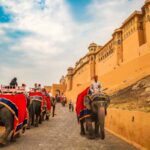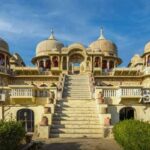Nawalgarh Travel Information, a picturesque town in the Shekhawati region of Rajasthan, India, is a hidden gem that beckons travelers with its rich cultural heritage, splendid architecture, and vibrant traditions. Steeped in history, Nawalgarh is renowned for its well-preserved havelis (traditional Indian mansions), fresco paintings, and a unique glimpse into the opulent past of Rajasthan.
One of the main attractions in Nawalgarh is the havelis, which showcase stunning murals and frescoes depicting mythological scenes, historical events, and everyday life. Walking through the narrow lanes, visitors are transported back in time, awestruck by the intricate artwork that adorns the walls of these majestic structures. Some of the must-visit havelis include the Poddar Haveli, Morarka Haveli, and Aath Haveli, each with its distinct architectural style and historical significance.
The town’s captivating bazaars offer a vibrant shopping experience, where tourists can buy traditional handicrafts, colorful textiles, and exquisite Rajasthani jewelry. The local markets are also renowned for their tie-and-dye fabrics, known as Bandhani, and intricately designed juttis (traditional footwear).
Nawalgarh’s cultural heritage comes alive during its various festivals, including Gangaur and Teej, when the town bursts with colors, music, and dance. Tourists can participate in these lively celebrations, gaining insight into the region’s vibrant customs and traditions. For history enthusiasts, Nawalgarh offers the Dr. Ramnath A. Podar Haveli Museum, which houses an impressive collection of antiques, vintage artifacts, and historical documents. The museum provides a deeper understanding of the town’s legacy and the lifestyle of the wealthy merchants who once inhabited the havelis.
Additionally, Nawalgarh boasts several nearby attractions, such as the Roop Niwas Palace and the famous Dundlod Fort. These architectural marvels offer a glimpse into the royal past of Rajasthan and the grandeur of its bygone era Rajasthan Monuments.
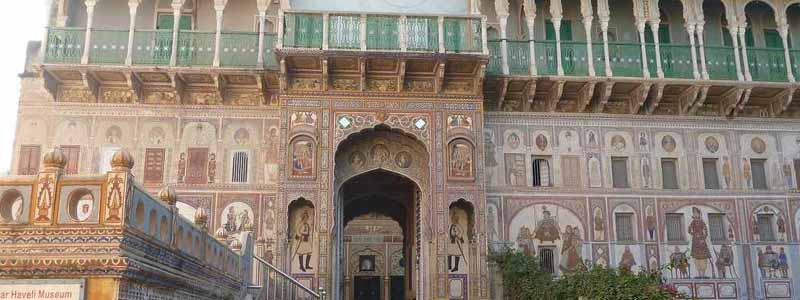
History of Nawalgarh
The history of Nawalgarh can be traced back to the 18th century when it was founded by Thakur Nawal Singh, a prominent Rajput warrior and ruler of the Shekhawati region. The town was established as a princely state under the Jaipur state, and the ruling family belonged to the Shekhawat clan of Rajputs.
Nawalgarh was strategically located on an ancient trade route that connected the wealthy cities of the Indian heartland with the ports of Gujarat. This advantageous position facilitated flourishing trade and commerce, contributing significantly to the town’s prosperity.
During the 19th and early 20th centuries, Nawalgarh became a flourishing center of trade, attracting wealthy Marwari merchants who built elaborate havelis and mansions. These traders, known for their business acumen and philanthropy, left a lasting impact on the town’s architecture and culture. The havelis they constructed were adorned with intricate frescoes and murals, showcasing their opulence and artistic tastes.
Nawalgarh, along with the other towns in the Shekhawati region, became known as the “Open Art Gallery of Rajasthan” due to the rich and exquisite artwork that adorned the havelis and public buildings. The frescoes depicted various themes, including mythology, folklore, historical events, and scenes from everyday life.
During the British colonial era, Nawalgarh was one of the princely states under British suzerainty. Like other princely states, it enjoyed a degree of autonomy while acknowledging the authority of the British crown. The rulers of Nawalgarh played a significant role in the administration and development of the town and its surrounding regions.
After India gained independence in 1947, Nawalgarh, along with other princely states, merged with the newly independent India. The town became a part of the state of Rajasthan, and the ruling family continued to hold considerable respect and influence in the region Nawalgarh Travel Information.
Today, Nawalgarh stands as a living testament to its glorious past. The well-preserved havelis and the rich cultural heritage continue to attract tourists from around the world, providing a fascinating glimpse into the splendor and grandeur of Rajasthan’s history and traditions.
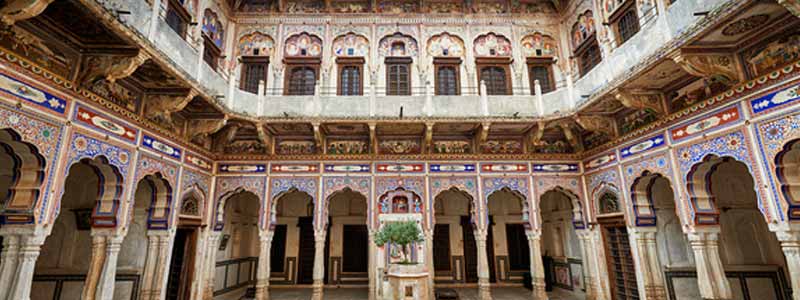
Places to Visit in Nawalgarh
Nawalgarh, a town rich in cultural heritage and architectural splendor, offers a plethora of attractions for visitors to explore. Here are some of the must-visit places in Nawalgarh:
Havelis: The town is famous for its stunning havelis adorned with intricate frescoes and murals. Poddar Haveli, Morarka Haveli, and Aath Haveli are among the most prominent havelis, each showcasing unique architectural styles and mesmerizing artwork.
Dr. Ramnath A. Podar Haveli Museum: This museum houses a diverse collection of antiques, artifacts, and historical documents, providing insights into the region’s history and the lifestyle of the erstwhile merchants.
Roop Niwas Palace: Located on the outskirts of Nawalgarh, this grand palace is a perfect blend of Rajput and colonial architecture. The palace has now been converted into a heritage hotel, offering a royal experience to its guests.
Sheesh Mahal: Also known as the Palace of Mirrors, this beautiful structure is renowned for its mirror work and intricate detailing. It offers a captivating sight during daylight as the sunlight reflects off the mirrors, creating a dazzling effect.
Dundlod Fort: Situated near Nawalgarh, Dundlod Fort is an impressive historical monument, showcasing the architectural prowess of the bygone era. The fort offers panoramic views of the surrounding countryside.
Nawalgarh Stepwell: Known as the Baoris of Nawalgarh, these stepwells were once a vital water source for the town. They are architecturally fascinating and provide a glimpse into the town’s water management system.
Aath Kambh Chhatri: This impressive cenotaph, supported by eight pillars, is a beautiful example of Rajasthani architecture and a peaceful spot to soak in the local ambiance.
Morarka Haveli Museum: Another haveli turned museum, the Morarka Haveli showcases artifacts, textiles, and handicrafts, giving visitors a deeper understanding of the region’s art and craft traditions.
Mandawa: While not in Nawalgarh itself, Mandawa is a nearby town renowned for its havelis and historic architecture, making it worth a visit during your trip to Nawalgarh.
Local Bazaars: The bustling markets of Nawalgarh offer an authentic shopping experience, with a variety of Rajasthani handicrafts, textiles, and jewelry available for purchase Nawalgarh Travel Information.
Exploring these places in Nawalgarh will provide travelers with a captivating journey through the history, culture, and architectural marvels of this beautiful town in the Shekhawati region of Rajasthan.
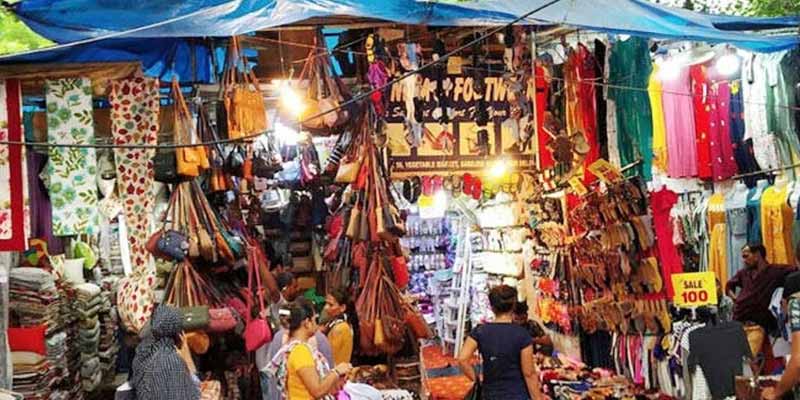
Famous Shopping Markets in Nawalgarh
Nawalgarh, with its rich cultural heritage, is a delightful destination for shopping enthusiasts. The town is known for its vibrant bazaars that offer a wide array of traditional Rajasthani handicrafts, textiles, and jewelry. Here are some of the famous shopping markets in Nawalgarh:
Podar Market: Located in the heart of Nawalgarh, Podar Market is one of the most popular shopping areas in the town. Here, you can find a diverse range of handicrafts, including wooden furniture, metalwork, and intricate paintings.
Raghunath Market: Raghunath Market is well-known for its colorful textiles and fabrics. Visitors can explore a wide range of traditional Rajasthani fabrics, including Bandhani (tie-and-dye), leheriya, and block-printed textiles.
Jhunjhunwala Market: This bustling market is a treasure trove for those seeking traditional Rajasthani jewelry. You can find a variety of beautifully crafted Kundan, Meenakari, and Thewa jewelry, as well as silver and tribal ornaments.
Lehriya Market: As the name suggests, this market specializes in leheriya textiles. Leheriya is a tie-and-dye technique that creates wave-like patterns on fabric, and the market offers an impressive selection of leheriya sarees, dupattas, and scarves.
Sanganeria Haveli Market: This market is situated near the Sanganeria Haveli and is a great place to shop for souvenirs and gift items. You can find miniature paintings, wooden handicrafts, and other mementos to take back home.
Hanuman Prasad Goenka Haveli Market: This market is known for its variety of locally made handicrafts, including clay pottery, camel leather items, and wooden toys. It’s an excellent spot to purchase unique and authentic Rajasthani crafts.
Johari Bazaar: Johari Bazaar, or the jewelry market, is the go-to place for jewelry enthusiasts. You can find exquisite silver and gold jewelry, as well as gemstone-studded pieces, reflecting the artistic finesse of Rajasthani jewelers Nawalgarh Travel Information.
Baba Ramdev Patola Art: This shop specializes in patola silk sarees, a traditional Rajasthani textile that features intricate geometric patterns. It’s an excellent place to buy a luxurious and unique saree.
While exploring these shopping markets in Nawalgarh, visitors can immerse themselves in the vibrant local culture and take home beautiful souvenirs that serve as cherished memories of their trip to this enchanting town in the Shekhawati region of Rajasthan.
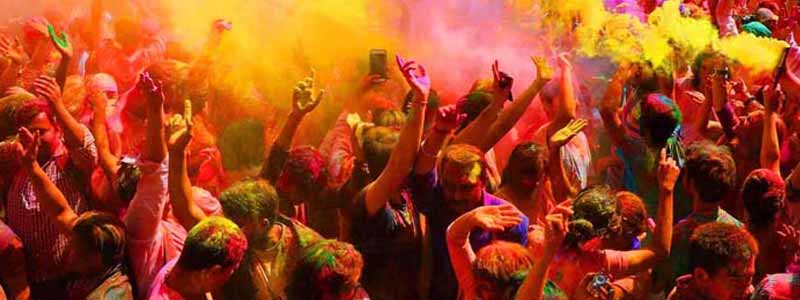
Fair & Festivals of Nawalgarh
Nawalgarh, like many other towns in Rajasthan, celebrates various colorful and vibrant festivals that showcase the region’s rich cultural heritage and traditional practices. Some of the prominent fairs and festivals celebrated in Nawalgarh are:
Gangaur: Gangaur is one of the most significant festivals in Rajasthan, including Nawalgarh. Celebrated in March/April, it is dedicated to Goddess Parvati, and women pray for the well-being and long life of their husbands. During this festival, colorful processions with beautifully adorned idols of Goddess Parvati are taken through the streets, accompanied by music, dance, and traditional rituals.
Teej: Teej is another popular festival celebrated with great enthusiasm in Nawalgarh. It usually falls in July/August and marks the advent of the monsoon season. Women dress up in colorful traditional attire, apply henna (mehndi) on their hands, and participate in various folk dances and singing competitions.
Holi: Like the rest of India, Nawalgarh celebrates Holi with fervor and joy. The festival of colors, usually observed in March, is marked by people splashing vibrant colors on each other, symbolizing the victory of good over evil and the arrival of spring.
Diwali: Diwali, the festival of lights, is celebrated with great enthusiasm in Nawalgarh. People illuminate their homes with diyas (oil lamps) and decorative lights, burst fireworks, and share sweets with family and friends to commemorate the triumph of light over darkness.
Navratri: Navratri, a nine-day festival dedicated to Goddess Durga, is celebrated with dance and music performances, particularly the energetic and colorful Garba and Dandiya Raas dances.
Makar Sankranti: Celebrated in January, Makar Sankranti marks the transition of the sun into the zodiac sign of Capricorn. Kite flying is a significant part of the festivities, and the skies of Nawalgarh are adorned with colorful kites during this time.
During these festivals, Nawalgarh comes alive with colors, music, dance, and a vibrant display of traditional customs. Tourists visiting Nawalgarh during these festive occasions can experience the essence of Rajasthani culture and witness the warmth and hospitality of the locals Nawalgarh Travel Information.
Best Time to Visit Nawalgarh
The best time to visit Nawalgarh is during the winter season, which spans from October to March. This period offers a pleasant and comfortable climate, making it ideal for sightseeing and exploring the town’s architectural marvels and cultural heritage. Here’s why the winter months are recommended for visiting Nawalgarh:
Weather: Winter in Nawalgarh is characterized by mild temperatures, with daytime temperatures ranging from 20°C to 25°C (68°F to 77°F). Nights can get cooler, dropping to around 5°C to 10°C (41°F to 50°F). The weather is quite pleasant during this time, making it suitable for outdoor activities and sightseeing.
Festivals: Many of the vibrant festivals celebrated in Nawalgarh, such as Diwali, Teej, and Makar Sankranti, fall during the winter months. Visiting during these festivals allows you to witness the town’s cultural vibrancy and participate in the lively celebrations.
Sightseeing: Exploring the intricately designed havelis and frescoes is a significant part of a trip to Nawalgarh. The pleasant weather during winter makes it more enjoyable to walk through the narrow lanes and admire the stunning architecture.
Comfortable Travel: The cooler temperatures during winter make travel more comfortable, especially when exploring outdoor attractions and markets. It’s also an excellent time to visit nearby attractions like Mandawa and Dundlod.
Wildlife: If you’re interested in wildlife, visiting the nearby Tal Chhapar Wildlife Sanctuary during the winter months is a rewarding experience. The sanctuary is home to a variety of bird species and wildlife, and the weather is suitable for wildlife safaris.
Although winter is the best time to visit Nawalgarh, it’s essential to note that the town can get crowded with tourists during this period, especially around festivals and peak tourist season. To avoid the crowds, consider planning your trip during the shoulder seasons of October-November or February-March when the weather is still pleasant, and there are fewer tourists.
In contrast, visiting Nawalgarh during the summer months (April to June) should be avoided as the temperatures can soar to extreme levels, making sightseeing and outdoor activities uncomfortable. The monsoon season (July to September) can bring heavy rains, which may hinder travel plans and exploration of the town Nawalgarh Travel Information.
How to Reach Nawalgarh
Nawalgarh is well-connected by road and rail, making it easily accessible from various parts of Rajasthan and neighboring states. Here are the primary modes of transportation to reach Nawalgarh:
By Air: The nearest airport to Nawalgarh is Jaipur International Airport, located approximately 160 kilometers (about 99 miles) away. From Jaipur, you can hire a taxi or take a bus to reach Nawalgarh, which usually takes around 3 to 4 hours, depending on the road conditions and traffic.
By Train: The nearest railway station to Nawalgarh is in Jhunjhunu, which is around 25 kilometers (about 15.5 miles) away. Jhunjhunu railway station is well-connected to major cities like Delhi, Jaipur, and Bikaner. From Jhunjhunu, you can hire a taxi or take a local bus to reach Nawalgarh in approximately 30 to 45 minutes.
By Road: Nawalgarh is well-connected by road and can be reached by both private and public transport.
- From Delhi: Nawalgarh is approximately 250 kilometers (about 155 miles) from Delhi. You can take a bus or hire a taxi from Delhi to reach Nawalgarh, which usually takes around 5 to 6 hours, depending on the traffic and road conditions.
- From Jaipur: Nawalgarh is around 140 kilometers (about 87 miles) from Jaipur. You can take a bus or hire a taxi from Jaipur to reach Nawalgarh, which usually takes around 3 to 4 hours.
- From Bikaner: Nawalgarh is approximately 220 kilometers (about 137 miles) from Bikaner. You can take a bus or hire a taxi from Bikaner to reach Nawalgarh, which usually takes around 4 to 5 hours.
Traveling by road allows you to enjoy the scenic countryside of Rajasthan and witness the rustic charm of the region.
Before planning your trip to Nawalgarh, it’s essential to check the current travel conditions and availability of transportation options. Also, consider making advance reservations for accommodation and transportation, especially during the peak tourist season, to ensure a smooth and enjoyable journey to this beautiful town in the Shekhawati region of Rajasthan.

